Streaming algorithms analyze your viewing habits—like what shows you watch, skip, or binge—to predict what you’ll want next. They build user profiles using your history and compare them with others to suggest content you’re likely to enjoy. Techniques like collaborative filtering and analyzing collective behaviors influence your choices without you realizing it. Platforms often favor popular or familiar options to keep you engaged. Keep exploring ways to gain control by understanding these tricks—more tips await if you continue.
Key Takeaways
- Streaming algorithms analyze your viewing history, preferences, and behavior to recommend content that maximizes engagement and retention.
- They often favor popular or similar content, creating echo chambers and limiting content diversity in your recommendations.
- Visual cues like thumbnails and genre shifts subtly influence your emotional responses and viewing choices.
- To outsmart these algorithms, diversify your watchlist, manually browse genres, and set personal viewing limits.
- Use features like “not interested” or curated playlists to steer recommendations away from manipulative patterns.
The Basics of Streaming Recommendations
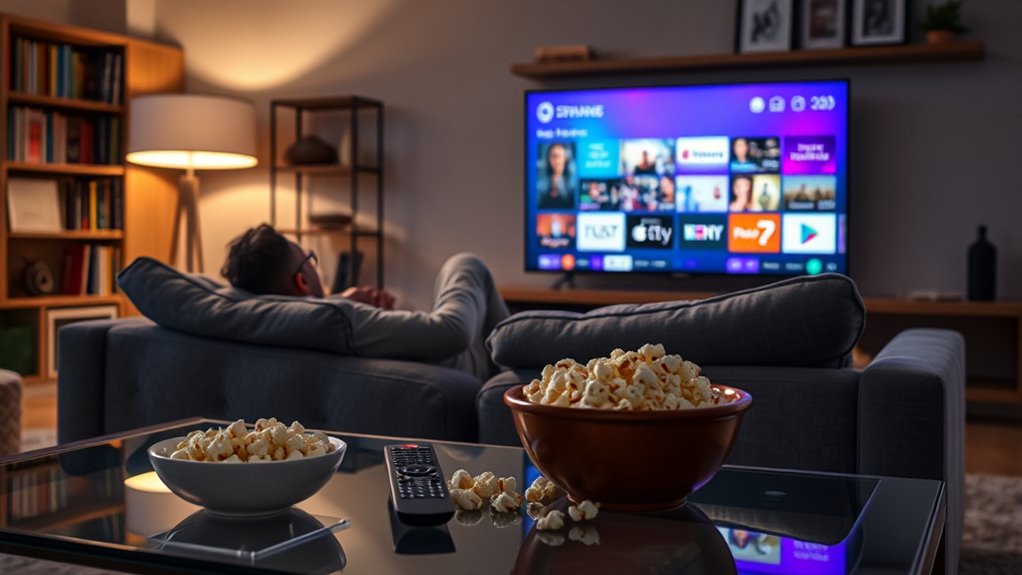
Streaming recommendations work by analyzing your viewing habits in real time to suggest content you’ll likely enjoy. This process relies heavily on content curation, where algorithms sift through vast amounts of data to find patterns in what you watch. They assess your preferences, genres, and viewing frequency to tailor suggestions that keep you hooked. This continuous process is driven by sophisticated recommendation algorithms that adapt to your evolving tastes. The goal is to boost viewer engagement by offering personalized options that seem relevant and appealing. As you watch, these algorithms continuously refine their understanding of your tastes, making recommendations more accurate over time. This constant feedback loop helps streaming platforms maintain your interest and increase the chances you’ll stick around longer. Ultimately, this sophisticated content curation creates a seamless, engaging experience designed to keep you watching.
How Algorithms Track Your Viewing Habits
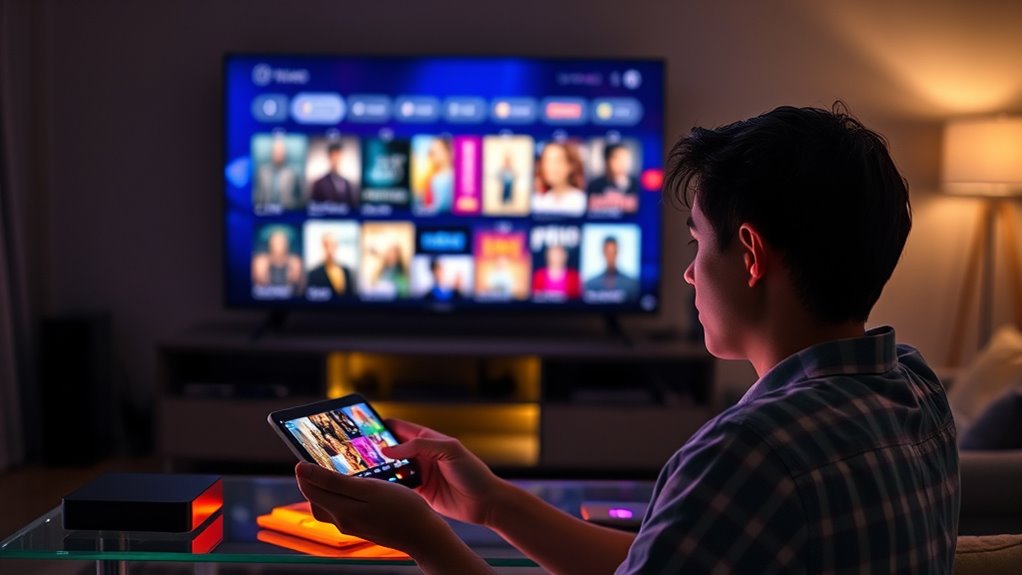
Streaming services collect data on what you watch, when, and how often. They use this information to build detailed profiles of your viewing habits. These profiles power personalized recommendation engines that aim to keep you watching. To optimize these algorithms, platforms analyze patterns in viewer engagement and adapt their suggestions accordingly, often employing dynamic communication exercises to refine user preferences and enhance engagement.
Viewing Data Collection
While you watch your favorite shows, algorithms are silently gathering data on your viewing habits. They track what you watch, when you watch, and how long you stay engaged. This data collection includes details like:
- Shows you pause or rewind
- Your search history
- Viewing time and frequency
- Devices used to stream
- Ratings or feedback you provide
This information raises privacy concerns, as it’s collected continuously without explicit awareness. Streaming services often monetize this data, using it to refine algorithms or sell insights to third parties. Your viewing habits become a valuable resource, influencing not only your recommendations but also the platform’s revenue strategies. Additionally, the collection of viewing data can lead to targeted advertising that feels intrusive. Being aware of this data collection helps you understand how your choices fuel larger business models behind the scenes.
Personalized Recommendation Engines
As your viewing habits are continuously tracked, algorithms analyze this data to create personalized recommendations tailored to your tastes. They consider your previous choices, watch times, and genre preferences to suggest what you might enjoy next. However, algorithm transparency isn’t always clear, leaving you unsure how your data influences these suggestions. Ethical considerations also come into play, as companies must balance personalized experiences with user privacy. While these engines aim to keep you engaged, they can inadvertently reinforce biases or limit diversity in your content choices. Being aware of how your data is used and advocating for transparency helps you understand the mechanics behind your recommendations. Additionally, filtration efficiency plays a role in how well these algorithms serve relevant content, ensuring that the suggestions align with your interests. Ultimately, understanding these processes empowers you to make more conscious viewing decisions and outsmart the algorithms when needed.
The Role of User Profiles and Viewing History
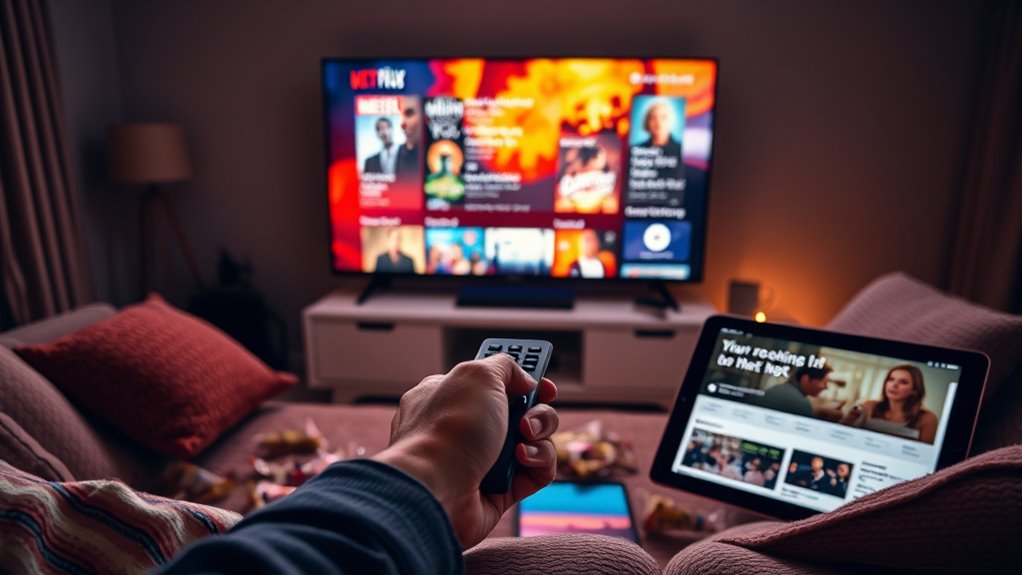
Your viewing history and user profile are the foundations streaming algorithms use to personalize recommendations. They track what you watch, when you watch, and how often, shaping your unique profile. This data enables viewer segmentation and demographic targeting, helping platforms understand your preferences and habits. Imagine these elements as a detailed map of your entertainment tastes, including:
- Genres you favor, like comedy or drama
- Time of day you binge most
- Content formats you prefer, such as movies or series
- Your engagement with specific actors or directors
- Watching patterns that reveal your mood or routines
This information helps algorithms predict what you’ll enjoy next, tailoring suggestions based on your habits. By analyzing your profile, streaming services aim to keep you hooked and engaged longer. Additionally, anime movies are often included in recommendations due to their popularity and diverse genres, influencing your viewing choices.
Machine Learning Techniques Behind Recommendations

Streaming platforms leverage advanced machine learning algorithms to analyze your viewing data and generate personalized recommendations. These algorithms use techniques like neural networks and decision trees to identify patterns and predict what you’ll enjoy next. To build trust, platforms are increasingly focusing on algorithm transparency, explaining how recommendations are made. Bias mitigation is also vital, as algorithms may unintentionally favor certain genres or creators, skewing suggestions. Developers implement fairness measures to reduce such biases, ensuring diverse, balanced recommendations. These techniques continuously learn from your interactions, refining suggestions over time. Additionally, understanding algorithm transparency can help viewers make more informed choices about their viewing habits. By understanding how machine learning powers recommendations, you can better recognize their influence and make more conscious choices about what you watch.
The Power of Collaborative Filtering
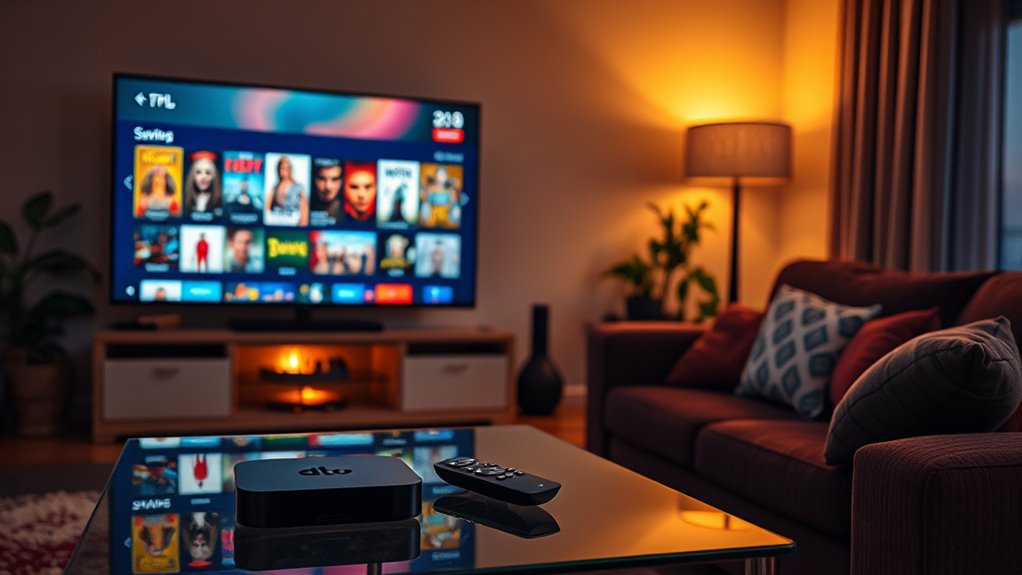
Have you ever noticed how streaming services recommend shows based on what similar users watch? That’s the power of collaborative filtering, which connects users through shared preferences. By analyzing these connections, algorithms can predict what you’re likely to enjoy next. Additionally, understanding the compatibility of preferences can help you outsmart these recommendations and discover content tailored to your unique tastes.
User Similarity Connections
Ever wondered how streaming platforms recommend shows you might love? It’s all about user similarity connections, a core part of collaborative filtering. Platforms analyze your viewing habits alongside others in your social network, finding patterns that reveal shared tastes. Imagine a network where:
- Your favorite sci-fi series links you to other fans
- Influencer marketing influences your viewing choices
- Similar users binge the same dramas
- Playlists and watchlists mirror those of your peers
- Recommendations emerge from collective preferences
This interconnected web helps platforms predict your next favorite, leveraging social network insights to personalize suggestions. By understanding these user similarity connections, streaming services tap into communal behavior, making your binge-watching experience feel uniquely tailored while subtly steering your choices through social influence. Additionally, Personality Traits can influence viewing preferences, further refining recommendation accuracy.
Preference Pattern Analysis
Preference pattern analysis lies at the heart of collaborative filtering, enabling platforms to identify shared tastes among users. By examining genre preferences and viewing frequency, streaming services detect patterns that reveal what groups of users enjoy most. If you often watch sci-fi and binge on new releases, the algorithm recognizes this trend among similar viewers. It then recommends content that aligns with these shared preferences, increasing the chances you’ll find something appealing. This analysis helps platforms personalize suggestions based on collective behaviors rather than just your individual history. As you watch more content, your preferences become clearer, allowing the system to refine its recommendations. Ultimately, preference pattern analysis creates a feedback loop that continuously adapts to your evolving tastes, making your next binge more targeted and satisfying.
Personalization vs. Popularity Bias
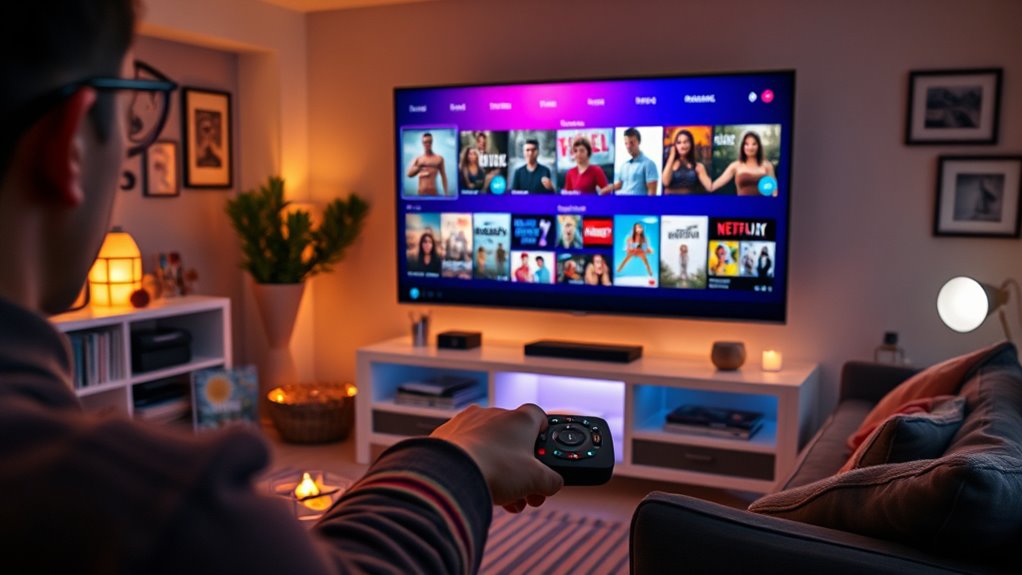
Streaming algorithms often face a trade-off between personalization and popularity bias. They aim to tailor recommendations to your tastes but can also favor trending content, amplifying algorithm bias. This creates a cycle where viewer influence shapes what’s promoted, sometimes limiting diversity. Imagine a system that:
Streaming algorithms balance personalized content with trending bias, often limiting diversity and reinforcing popular choices.
- Highlights blockbuster hits, overshadowing niche favorites
- Repeats familiar genres, reinforcing habits
- Prioritizes popular shows over hidden gems
- Uses past viewing to push similar content, reducing variety
- Creates echo chambers, where shared preferences influence others
This tug-of-war impacts your choices, making you see what’s trending or what the algorithm thinks you’ll like most. Understanding this helps you navigate the system, breaking free from popularity bias and discovering more diverse content beyond your usual preferences. Recognizing the role of algorithmic influence can empower you to seek out unique and varied entertainment options.
Common Tricks Used to Keep You Watching

How do streaming platforms keep you glued to the screen for longer than you intended? They use emotional triggers and clever content curation to tap into your subconscious. By selecting shows that evoke strong feelings—like excitement, fear, or nostalgia—they make it hard to stop watching. The algorithms also craft seamless progressions between episodes, reducing your chances of pausing. They present you with a steady stream of similar content, creating a sense of familiarity that encourages binge-watching. These tricks manipulate your emotional responses and keep you engaged without you realizing it. Additionally, their design leverages principles of the Law of Attraction, intentionally drawing your attention to content that aligns with your current emotional state, making it even harder to break free from the cycle. Basically, streaming platforms design their recommendations and interfaces to maximize your time on their platform, making it almost automatic to stay hooked. Awareness of these tricks can help you regain control over your viewing habits.
Recognizing When You’re Being Targeted

To recognize when you’re being targeted by streaming algorithms, pay attention to how content seems tailored to your habits and emotional responses. Emotional targeting often triggers feelings like excitement, nostalgia, or curiosity, pushing you to keep watching. Visual cues also play a role, subtly guiding your choices through striking thumbnails, color schemes, or scene compositions that catch your eye. You might notice:
- Thumbnails that evoke strong emotions or memories
- Sudden shifts in genre or tone matching your mood
- Repetitive themes designed to deepen engagement
- Bright, contrasting colors that draw your attention
- Narratives that subtly tap into your fears or desires
Being aware of these cues helps you identify when you’re being subtly manipulated, so you can make more conscious viewing choices.
Strategies to Take Control of Your Viewing Choices

Once you start noticing the subtle cues streaming algorithms use to influence your choices, you can take active steps to regain control. Focus on understanding your viewing habits and intentionally shaping your content curation. Set specific limits for your screen time and diversify your selections instead of relying on algorithm-driven recommendations. Create playlists or watchlists that reflect your true interests, rather than what algorithms suggest. Use features like “skip” or “not interested” to filter out unwanted content. Consider browsing categories or genres manually instead of scrolling through personalized feeds. By consciously managing your viewing habits and curating your content selection, you reduce the algorithm’s influence and make more intentional viewing decisions. This way, you stay in control of what you watch.
Tips for Discovering New Content Independently
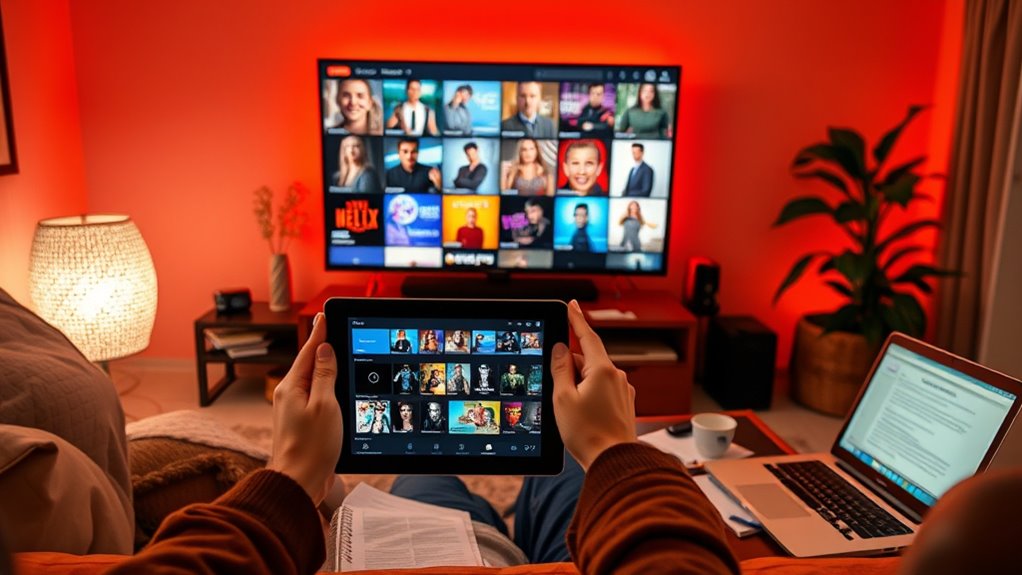
Ever wonder how to find fresh, exciting content beyond the confines of algorithmic suggestions? Independent exploration is your key to uncovering diverse entertainment options. To boost content diversity, try these strategies:
Discover unique entertainment by exploring niche genres, indie creators, and community events beyond algorithms.
- Browse niche genres or international films
- Check out curated lists from independent critics
- Explore underground or lesser-known creators on social media
- Attend virtual film festivals or community events
- Join online forums dedicated to specific interests
These approaches help you break free from algorithmic echo chambers and discover hidden gems. By actively seeking out new sources, you expand your horizons and enjoy a richer, more varied streaming experience. Independent exploration empowers you to control your content journey, ensuring your binge sessions stay fresh and inspiring.
Frequently Asked Questions
How Do Streaming Algorithms Decide What to Recommend Next?
Streaming algorithms decide what to recommend next by analyzing your viewing history and preferences, creating a tailored experience through viewer personalization. They consider factors like your past choices and similar users’ habits, but algorithm biases can influence suggestions unfairly. To outsmart them, you can diversify your viewing, clear watch history, or use private browsing. This way, you regain control and discover content beyond algorithm-driven suggestions.
Can Users Manipulate Recommendations to See Different Content?
Ever wonder if you can outsmart the system? You can influence recommendations by intentionally watching diverse content, which helps counteract algorithm biases. While algorithms favor your past viewing habits, your user influence—like liking, rating, or skipping shows—can subtly shift what’s suggested. However, savvy algorithms adapt over time, so manipulating recommendations isn’t foolproof. Still, actively engaging with different genres can steer your next binge in a new direction.
What Hidden Factors Influence Your Viewing Suggestions?
Hidden factors like your viewing patterns and user profiles considerably influence your recommendations. Streaming platforms analyze what you watch, when you watch, and how often to predict your preferences. They also consider your interactions, such as searches and skips, to refine suggestions. By understanding these factors, you can better anticipate or even manipulate your viewing suggestions—making it easier to discover new content tailored to your habits.
Are There Privacy Concerns With Streaming Recommendation Data?
Imagine your viewing habits as a secret garden; streaming services tend to peek inside with every click. Yes, there are privacy risks, and your data security can be compromised if the platforms don’t protect your info. Your personal preferences become a trail of footprints, making it easier for third parties to track you. Stay alert, read privacy policies, and use privacy tools to keep your digital garden safe from unwelcome visitors.
How Often Do Recommendation Algorithms Update Their Suggestions?
Recommendation algorithms update suggestions frequently, often daily or even hourly, to reflect your latest viewing habits. This rapid updating aims to improve personalization bias, making suggestions more relevant. However, it can also limit content diversity, trapping you in a filter bubble. To outsmart these algorithms, try exploring different genres or turning off personalized recommendations temporarily, encouraging broader exposure and breaking free from repetitive suggestions.
Conclusion
Just like Orpheus chasing Eurydice through the underworld, streaming algorithms lure you deeper into familiar stories, making it hard to break free. But remember, the power to choose is yours—break the spell by exploring new genres and trusting your instincts. Don’t let the siren song of endless recommendations drown out your true curiosity. Reclaim your viewing journey and discover the stories waiting beyond the algorithm’s grasp.









